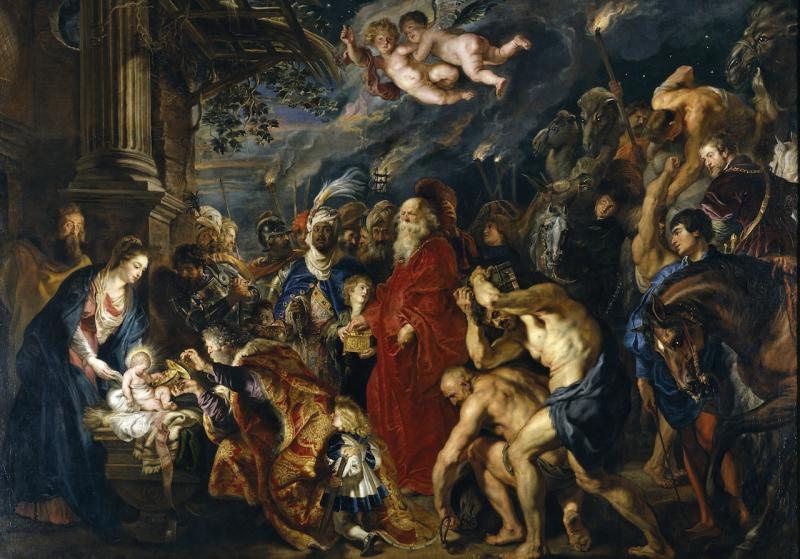Yuletide Scenes 2: The Adoration of the Magi | reviews, news & interviews
Yuletide Scenes 2: The Adoration of the Magi
Yuletide Scenes 2: The Adoration of the Magi
Peter Paul Rubens's baroque nativity is the second in our series of irresistible seasonal images

Rubens's gigantic masterpiece loudly contradicts the folkloric silent night. This typically muscular painting is deafening in its depiction of the commotion around the holy family when the Magi arrive to offer gifts to the divine king of Christian belief.
The message here is that all earthly kingdoms must submit to God, and, by extension, the Catholic Church Originally painted for the Antwerp Town Hall in 1609 to commemorate a truce between Spain (at its imperial height) and the Netherlands, the original painting was given over to the Spanish in 1621 perhaps to win favour for Antwerp as aggression still loomed. When Rubens joined the Spanish court in 1628, he expanded the size of the canvas and reworked the painting while still under the stylistic influence of Titian. With its wedge-like composition and writhing figures clad in drapery, there’s more than a passing resemblance between this painting and, say, Titian’s Bacchus and Ariadne which hangs in our own National Gallery. Rubens added a self portrait on the far right and increased the height of the canvas to include the flying putti and the inclined camel’s head which pushes our eye back across the action toward the infant Jesus.
It’s a painting which underscores the political power in Christian art, particularly at its height in the post-reformation baroque period, during which painted and sculpted Christian allegories were wielded as increasingly theatrical weapons of influence and persuasion as kingdoms competed for the souls of their subjects. One of a series of Adorations by Rubens, who was an emissary for the Spanish Court, the message here is that all earthly kingdoms, in their racial and regional diversity, must submit to God and, by extension, the Roman Catholic Church.
The future of Arts Journalism
You can stop theartsdesk.com closing!
We urgently need financing to survive. Our fundraising drive has thus far raised £33,000 but we need to reach £100,000 or we will be forced to close. Please contribute here: https://gofund.me/c3f6033d
And if you can forward this information to anyone who might assist, we’d be grateful.

Subscribe to theartsdesk.com
Thank you for continuing to read our work on theartsdesk.com. For unlimited access to every article in its entirety, including our archive of more than 15,000 pieces, we're asking for £5 per month or £40 per year. We feel it's a very good deal, and hope you do too.
To take a subscription now simply click here.
And if you're looking for that extra gift for a friend or family member, why not treat them to a theartsdesk.com gift subscription?
more Visual arts
 Help to give theartsdesk a future!
Support our GoFundMe appeal
Help to give theartsdesk a future!
Support our GoFundMe appeal
 Electric Dreams: Art and Technology Before the Internet, Tate Modern review - an exhaustive and exhausting show
Flashing lights, beeps and buzzes are diverting, but quickly pall
Electric Dreams: Art and Technology Before the Internet, Tate Modern review - an exhaustive and exhausting show
Flashing lights, beeps and buzzes are diverting, but quickly pall
 ARK: United States V by Laurie Anderson, Aviva Studios, Manchester review - a vessel for the thoughts and imaginings of a lifetime
Despite anticipating disaster, this mesmerising voyage is full of hope
ARK: United States V by Laurie Anderson, Aviva Studios, Manchester review - a vessel for the thoughts and imaginings of a lifetime
Despite anticipating disaster, this mesmerising voyage is full of hope
 Lygia Clark: The I and the You, Sonia Boyce: An Awkward Relation, Whitechapel Gallery review - breaking boundaries
Two artists, 50 years apart, invite audience participation
Lygia Clark: The I and the You, Sonia Boyce: An Awkward Relation, Whitechapel Gallery review - breaking boundaries
Two artists, 50 years apart, invite audience participation
 Mike Kelley: Ghost and Spirit, Tate Modern review - adolescent angst indefinitely extended
The artist who refused to grow up
Mike Kelley: Ghost and Spirit, Tate Modern review - adolescent angst indefinitely extended
The artist who refused to grow up
 Monet and London, Courtauld Gallery review - utterly sublime smog
Never has pollution looked so compellingly beautiful
Monet and London, Courtauld Gallery review - utterly sublime smog
Never has pollution looked so compellingly beautiful
 Michael Craig-Martin, Royal Academy review - from clever conceptual art to digital decor
A career in art that starts high and ends low
Michael Craig-Martin, Royal Academy review - from clever conceptual art to digital decor
A career in art that starts high and ends low
 Van Gogh: Poets & Lovers, National Gallery review - passions translated into paint
Turmoil made manifest
Van Gogh: Poets & Lovers, National Gallery review - passions translated into paint
Turmoil made manifest
 Peter Kennard: Archive of Dissent, Whitechapel Gallery review - photomontages sizzling with rage
Fifty years of political protest by a master craftsman
Peter Kennard: Archive of Dissent, Whitechapel Gallery review - photomontages sizzling with rage
Fifty years of political protest by a master craftsman
 Dominique White: Deadweight, Whitechapel Gallery review - sculptures that seem freighted with history
Dunked in the sea to give them a patina of age, sculptures that feel timeless
Dominique White: Deadweight, Whitechapel Gallery review - sculptures that seem freighted with history
Dunked in the sea to give them a patina of age, sculptures that feel timeless
 Bill Viola (1951-2024) - a personal tribute
Video art and the transcendent
Bill Viola (1951-2024) - a personal tribute
Video art and the transcendent

Add comment